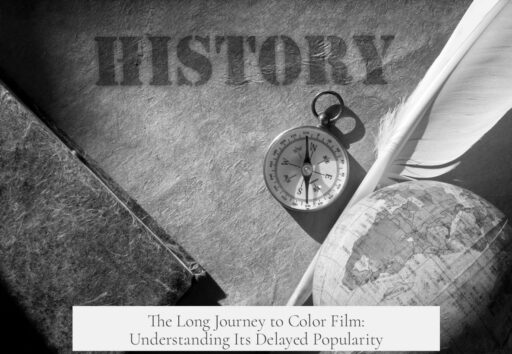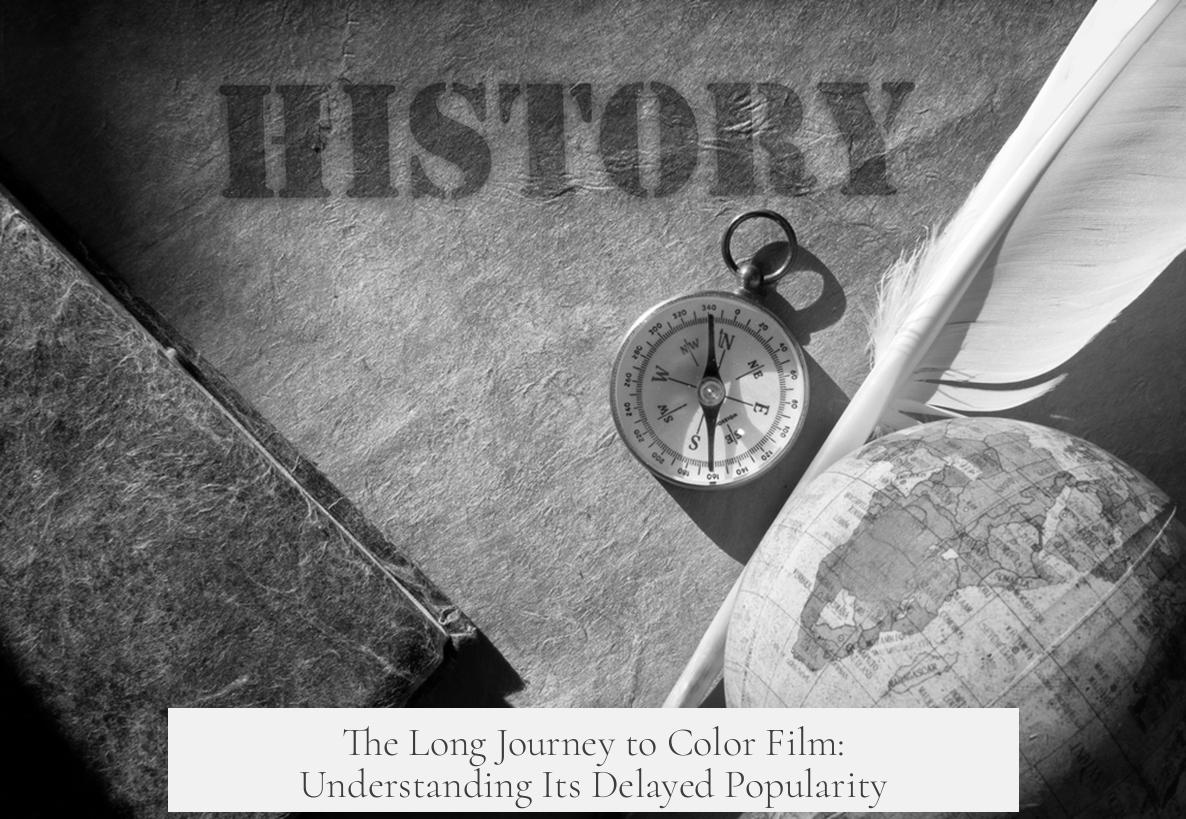Color film took a long time to become common due to its complex development, high costs, technical limitations, and the existing dominance of black and white photography. Early color film processes required capturing images through separate red, green, and blue filters on different plates or films. These were then combined into a full-color photograph, a method that demanded precise alignment and multiple steps.
The first commercially available consumer color film, Kodachrome, exemplifies this complexity. Developing Kodachrome involved more than twice the number of steps required for black and white film, utilizing intricate chemical processes that were difficult for amateurs and demanding even for professionals. Integrated color films simplified the capturing process but still required advanced chemical handling in the lab, making home development unrealistic.
The cost of color film and processing was significantly higher than black and white. Color images required at least three times the work, materials, and specialized equipment. These expenses hindered widespread adoption especially among casual photographers, who found black and white film more affordable and accessible.
Film speed limitations further restricted color film’s appeal. Early color films had slow ISO speeds, often below ISO 200. This made indoor and low-light photography difficult without long exposures or expensive lighting. Images taken with slow film indoors risked underexposure or blurring, restricting color film to well-lit outdoor scenes and specialized uses.
In contrast, black and white film was simpler to develop and print, cheaper, and available in a range of speeds from many manufacturers. These factors made black and white the practical choice for many decades.
Attempts to create integrated color films began with Agfa’s 1936 film, incorporating all three color dyes into a single emulsion. However, this approach did not gain immediate traction. Kodak’s later development of a similar, more robust process helped push color film into more widespread consumer use.
- Early color film required multiple exposures or filters, complicating development.
- Kodachrome involved highly complex chemical processing.
- Color film development cost far more than black and white film.
- Slow film speeds made color film impractical indoors or in low light.
- Black and white film was simpler, cheaper, and more versatile.
- Integrated color films existed early but became popular only after Kodak’s improvements.
Why Did Color Film Take So Long to Become Common?

The simple answer: color film’s complexity, cost, and early technological limitations kept it in the shadows of black and white photography for decades. But let’s dive deeper. Why did capturing a photo in glorious color remain a niche, expensive hobby instead of a household standard until relatively recently? It’s a story packed with chemistry puzzles, economic realities, and inventors’ slow-but-steady triumphs.
Color film’s journey reads like a classic underdog tale. It starts complicated, expensive, and slow but gradually becomes the mainstream powerhouse we now take for granted.
The Complexity of Color Film Development
Early color photography wasn’t as easy as snapping a photo and waiting for a few minutes. Instead, it was a *seriously* tangled process. Take Kodachrome, one of the first commercially available consumer color films. While revolutionary, it practically demanded a PhD in chemistry to develop.
Kodachrome required more than double the steps of black and white film development, spreading the process over a series of intricate chemical baths. It wasn’t something you could just do in your garage darkroom. It needed specialized labs, trained technicians, and time. The development was so challenging, that photographers sometimes called it “alchemy.”
“They Took My Kodachrome Away, So I Brought It Back” — This article highlights just how finicky and delicate Kodachrome processing was. (Read it here: emulsive.org)
Before integrated color films, the method captured images by using three separate color filters—red, green, and blue—each onto a different medium like glass plates or film strips. These had to be perfectly aligned and merged to produce a natural color photograph. This process wasn’t exactly “user-friendly.”
Even when integrated color films hit the market, simplifying how photographers captured scenes in full color, the development process stayed tricky. Chemical baths were complex, slow, and prone to errors that could ruin hours of work.
The Cost Barrier: Why Black and White Film Won for Decades
The complexity of color film translated directly to cost. Developing a color photograph meant triple the labor, materials, and equipment compared to black and white prints. Even though the idea of vibrant images tantalized customers, the price tag kept most at bay.
To put it bluntly, color film photography was expensive — like designer coffee in a sea of instant brews. Labs charged premiums, specialized equipment was required, and mistakes during development meant money down the drain. This hefty cost made black and white film the default choice for decades.
Because black and white film was simpler and cheaper, it dominated both professional and amateur photography. It was available in various speeds, formats, and brands. Consumers could pick up and develop black and white rolls in local shops without breaking the bank.
Film Speed Limitations: The Stumbling Block of Image Quality
Technology lagged behind demand. Early color films had painfully slow ISO ratings, often below ISO 200. For photographers, this meant they needed bright daylight just to get a decent shot. Indoors or in low light, photos came out as dark, blurry mysteries.
Imagine trying to capture your kid’s birthday party with film that lets in so little light you need to turn on every lamp just to get a shot. Slow film speed made color photography less practical, pushing many to stick with black and white, which offered faster film speeds making indoor or artistic shots possible.
Thus, color film wasn’t just expensive to develop; it was difficult to shoot with, amplifying its slow adoption.
Why Black and White Film Stayed King for the Long Haul

Black and white film’s simplicity was its genius. It was easy to develop, print, and handle. Enthusiasts and professionals knew the ropes. Affordable, widely distributed, and forgiving, it stood on a solid pedestal while color film stumbled up the learning curve.
Furthermore, black and white film let photographers experiment with shutter speed, exposure, and lighting conditions without being penalized by the technical limitations of color emulsions.
The Rise of Integrated Color Film: A Slow Dawn
Some early innovators tried to change the game. Agfa, a departed film giant, introduced a color film in 1936 that incorporated three layers with different color dyes right into a single emulsion. This meant you could develop the photo in one chemical bath, a giant leap forward.
Unfortunately, the market wasn’t ready. This early integrated color film faced manufacturing challenges and skepticism. Kodak’s later innovation, their color film process, gained traction and really made integrated color photography practical.
By the mid-20th century, color film technology steadily improved with faster speeds, simplified development, and dropping costs. Still, it took decades before this tech became affordable and convenient enough for everyday use.
The Big Picture: Patience, Innovation, and Market Forces
The slow march of color film wasn’t just about science. It’s a lesson in how inventions need more than a cool idea—they need adoption, manufacturing advances, and affordability.
Consider this: how many brilliant tech ideas fail simply because they’re ahead of their time? Sometimes, the infrastructure and market readiness must catch up first. Color film is a perfect example.
What Can We Learn? Practical Tips for Aspiring Film Photographers
- Experimenting with Black & White: For beginners, black and white film still offers an easier and cheaper pathway to learn the craft and develop skills.
- Specialize in Color: If you want to shoot color, look for modern film stocks that balance ease of development with vibrant results, like Kodak Portra or Fuji Pro 400H.
- Patience for Development: Color film requires patience and precision during development. Partner with a reputable lab or learn the process carefully at home if you want DIY.
Understanding the hurdles color film faced helps us appreciate how far film photography has come. It’s not just nostalgia—it’s a testament to decades of chemistry experiments, inventors’ grit, and photographers’ passion.
So next time you admire a stunning vintage color photo, tip your hat to those who endured the complex, costly, slow processes that made it possible. The colors you see are the product of tenacity and clever science. Color film didn’t just appear overnight—it earned its place.
Why was Kodachrome color film difficult to develop?
Kodachrome required more than double the developing steps of black and white film. Its process was complex and involved many chemical baths, making it challenging and time-consuming for labs to handle.
How did the early color film capture images?
Early color film used separate filters for red, green, and blue. Each color captured on different plates or films had to be combined later to create a full-color photograph, adding complexity to the process.
Why was color film more expensive than black and white film?
Color film development needed more materials and time. Essentially, it required triple the work to produce a color image, which raised the cost and slowed down its adoption among everyday consumers.
What role did film speed play in color film’s slow popularity?
Early color films had low ISO speeds, often below 200. This meant they struggled in low light and indoors, leading to blurred or underexposed images. Consumers found this impractical for general use.
How did black and white film’s ease of use affect color film adoption?
Black and white film was easier and cheaper to develop and print. Its wider availability and faster speeds made it a preferred choice until color film technology improved and costs dropped.
When did integrated color film technology become common?
Agfa introduced integrated color film in 1936, but it gained real traction only after Kodak refined the process later. This development simplified color film processing, paving the way for its widespread use.



